PKCβ and reactive oxygen species mediate enhanced pulmonary vasoconstrictor reactivity following chronic hypoxia in neonatal rats
- PMID: 31922892
- PMCID: PMC7052628
- DOI: 10.1152/ajpheart.00629.2019
PKCβ and reactive oxygen species mediate enhanced pulmonary vasoconstrictor reactivity following chronic hypoxia in neonatal rats
Abstract
Reactive oxygen species (ROS), mitochondrial dysfunction, and excessive vasoconstriction are important contributors to chronic hypoxia (CH)-induced neonatal pulmonary hypertension. On the basis of evidence that PKCβ and mitochondrial oxidative stress are involved in several cardiovascular and metabolic disorders, we hypothesized that PKCβ and mitochondrial ROS (mitoROS) signaling contribute to enhanced pulmonary vasoconstriction in neonatal rats exposed to CH. To test this hypothesis, we examined effects of the PKCβ inhibitor LY-333,531, the ROS scavenger 1-oxyl-2,2,6,6-tetramethyl-4-hydroxypiperidine (TEMPOL), and the mitochondrial antioxidants mitoquinone mesylate (MitoQ) and (2-(2,2,6,6-tetramethylpiperidin-1-oxyl-4-ylamino)-2-oxoethyl)triphenylphosphonium chloride (MitoTEMPO) on vasoconstrictor responses in saline-perfused lungs (in situ) or pressurized pulmonary arteries from 2-wk-old control and CH (12-day exposure, 0.5 atm) rats. Lungs from CH rats exhibited greater basal tone and vasoconstrictor sensitivity to 9,11-dideoxy-9α,11α-methanoepoxy prostaglandin F2α (U-46619). LY-333,531 and TEMPOL attenuated these effects of CH, while having no effect in lungs from control animals. Basal tone was similarly elevated in isolated pulmonary arteries from neonatal CH rats compared with control rats, which was inhibited by both LY-333,531 and mitochondria-targeted antioxidants. Additional experiments assessing mitoROS generation with the mitochondria-targeted ROS indicator MitoSOX revealed that a PKCβ-mitochondrial oxidant signaling pathway can be pharmacologically stimulated by the PKC activator phorbol 12-myristate 13-acetate in primary cultures of pulmonary artery smooth muscle cells (PASMCs) from control neonates. Finally, we found that neonatal CH increased mitochondrially localized PKCβ in pulmonary arteries as assessed by Western blotting of subcellular fractions. We conclude that PKCβ activation leads to mitoROS production in PASMCs from neonatal rats. Furthermore, this signaling axis may account for enhanced pulmonary vasoconstrictor sensitivity following CH exposure.NEW & NOTEWORTHY This research demonstrates a novel contribution of PKCβ and mitochondrial reactive oxygen species signaling to increased pulmonary vasoconstrictor reactivity in chronically hypoxic neonates. The results provide a potential mechanism by which chronic hypoxia increases both basal and agonist-induced pulmonary arterial smooth muscle tone, which may contribute to neonatal pulmonary hypertension.
Keywords: PKCβ; mitochondria; oxidative stress; pulmonary hypertension; vascular disease.
Conflict of interest statement
No conflicts of interest, financial or otherwise, are declared by the authors.
Figures
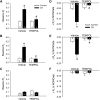



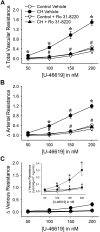
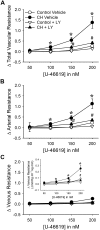


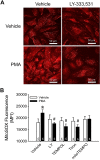
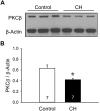

Similar articles
-
Intermittent Hypoxia Augments Pulmonary Vasoconstrictor Reactivity through PKCβ/Mitochondrial Oxidant Signaling.Am J Respir Cell Mol Biol. 2020 Jun;62(6):732-746. doi: 10.1165/rcmb.2019-0351OC. Am J Respir Cell Mol Biol. 2020. PMID: 32048876 Free PMC article.
-
Enhanced NO-dependent pulmonary vasodilation limits increased vasoconstrictor sensitivity in neonatal chronic hypoxia.Am J Physiol Heart Circ Physiol. 2017 Oct 1;313(4):H828-H838. doi: 10.1152/ajpheart.00123.2017. Epub 2017 Jul 21. Am J Physiol Heart Circ Physiol. 2017. PMID: 28733445 Free PMC article.
-
Actin polymerization contributes to enhanced pulmonary vasoconstrictor reactivity after chronic hypoxia.Am J Physiol Heart Circ Physiol. 2018 May 1;314(5):H1011-H1021. doi: 10.1152/ajpheart.00664.2017. Epub 2018 Jan 26. Am J Physiol Heart Circ Physiol. 2018. PMID: 29373038 Free PMC article.
-
Vasoconstrictor Mechanisms in Chronic Hypoxia-Induced Pulmonary Hypertension: Role of Oxidant Signaling.Antioxidants (Basel). 2020 Oct 15;9(10):999. doi: 10.3390/antiox9100999. Antioxidants (Basel). 2020. PMID: 33076504 Free PMC article. Review.
-
Interactions between calcium and reactive oxygen species in pulmonary arterial smooth muscle responses to hypoxia.Respir Physiol Neurobiol. 2010 Dec 31;174(3):221-9. doi: 10.1016/j.resp.2010.08.014. Epub 2010 Aug 27. Respir Physiol Neurobiol. 2010. PMID: 20801238 Free PMC article. Review.
Cited by
-
Superoxide-Mediated Upregulation of MMP9 Participates in BMPR2 Destabilization and Pulmonary Hypertension Development.Antioxidants (Basel). 2023 Nov 2;12(11):1961. doi: 10.3390/antiox12111961. Antioxidants (Basel). 2023. PMID: 38001814 Free PMC article.
-
Hypoxia-induced pulmonary hypertension in adults and newborns: implications for drug development.Drug Discov Today. 2024 Jun;29(6):104015. doi: 10.1016/j.drudis.2024.104015. Epub 2024 May 6. Drug Discov Today. 2024. PMID: 38719143 Free PMC article. Review.
-
DNA Damage, n-3 Long-Chain PUFA Levels and Proteomic Profile in Brazilian Children and Adolescents.Nutrients. 2021 Jul 21;13(8):2483. doi: 10.3390/nu13082483. Nutrients. 2021. PMID: 34444642 Free PMC article.
-
Hypoxia and the integrated stress response promote pulmonary hypertension and preeclampsia: Implications in drug development.Drug Discov Today. 2021 Nov;26(11):2754-2773. doi: 10.1016/j.drudis.2021.07.011. Epub 2021 Jul 22. Drug Discov Today. 2021. PMID: 34302972 Free PMC article. Review.
-
NFAT5/TonEBP Limits Pulmonary Vascular Resistance in the Hypoxic Lung by Controlling Mitochondrial Reactive Oxygen Species Generation in Arterial Smooth Muscle Cells.Cells. 2021 Nov 24;10(12):3293. doi: 10.3390/cells10123293. Cells. 2021. PMID: 34943801 Free PMC article.
References
-
- Abman SH, Hansmann G, Archer SL, Ivy DD, Adatia I, Chung WK, Hanna BD, Rosenzweig EB, Raj JU, Cornfield D, Stenmark KR, Steinhorn R, Thébaud B, Fineman JR, Kuehne T, Feinstein JA, Friedberg MK, Earing M, Barst RJ, Keller RL, Kinsella JP, Mullen M, Deterding R, Kulik T, Mallory G, Humpl T, Wessel DL; American Heart Association Council on Cardiopulmonary, Critical Care, Perioperative and Resuscitation; Council on Clinical Cardiology; Council on Cardiovascular Disease in the Young; Council on Cardiovascular Radiology and Intervention; Council on Cardiovascular Surgery and Anesthesia; and the American Thoracic Society . Pediatric pulmonary hypertension: guidelines from the American Heart Association and American Thoracic Society. Circulation 132: 2037–2099, 2015. [Erratum in Circulation 133: e368, 2016.] doi:10.1161/CIR.0000000000000329. - DOI - PubMed
-
- Afolayan AJ, Eis A, Alexander M, Michalkiewicz T, Teng RJ, Lakshminrusimha S, Konduri GG. Decreased endothelial nitric oxide synthase expression and function contribute to impaired mitochondrial biogenesis and oxidative stress in fetal lambs with persistent pulmonary hypertension. Am J Physiol Lung Cell Mol Physiol 310: L40–L49, 2016. doi:10.1152/ajplung.00392.2014. - DOI - PMC - PubMed
-
- Afolayan AJ, Eis A, Teng RJ, Bakhutashvili I, Kaul S, Davis JM, Konduri GG. Decreases in manganese superoxide dismutase expression and activity contribute to oxidative stress in persistent pulmonary hypertension of the newborn. Am J Physiol Lung Cell Mol Physiol 303: L870–L879, 2012. doi:10.1152/ajplung.00098.2012. - DOI - PMC - PubMed
Publication types
MeSH terms
Substances
Grants and funding
LinkOut - more resources
Full Text Sources
Research Materials
Miscellaneous

